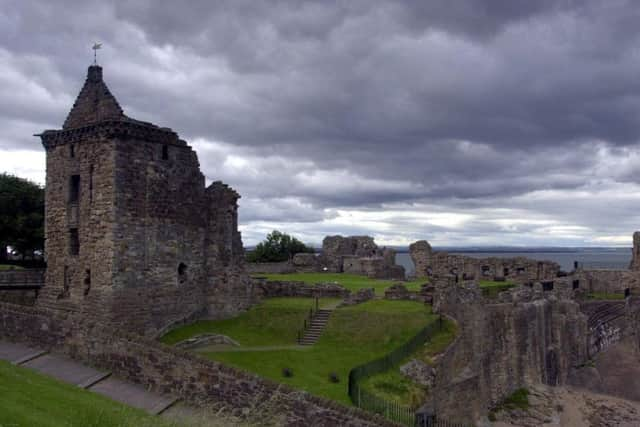Five Scottish castles with a dark past


Dunottar Castle
It’s regarded as one of Scotland’s most spectacular historic sites, but Dunottar Castle in Aberdeenshire has endured a torrid past.
It was recaptured in 1297 following a lengthy siege orchestrated by none other than William Wallace.
Advertisement
Hide AdAdvertisement
Hide Ad

No mercy was shown. Wallace ransacked the castle before rounding up the English soliders in the church and setting it alight. It is thought that 4,000 men were burned to death. Some managed to escape, but their only option was to dive off the steep cliff and on to the rocks below.
The poet Bind Harry wrote about the chilling incident in his 15th century epic ‘Wallace’:
Therefore a fire was brought speedily
Which burnt the church, and all those South’ron boys


Out o’er the rock the rest rush’d great noise
Some hung on craigs, and loath were to die
Some lap, some fell, some flutter’d in the sea
And perish’d all, not one remain’d alive.


Stirling Castle
Few places in Scotland have experienced a more bloody history than Stirling Castle.
One of its most violent incidents, however, occurred in 1452, when the body of William Earl of Douglas was discovered at the foot of a tower.
The 27-year-old earl was a close friend of the young King James II, but at some point - and we don’t know over what exactly - they fell out and their friendship turned sour.


Aided by his courtiers, James II murdered William in the most brutal fashion imaginable. His body was stabbed 26 times before being thrown from a castle window into the garden below.
Dunaverty Castle
Clinging to a rocky outcrop on the coast of the Kintrye peninsula stands the ruin of Dunaverty Castle, the scant remains of a 13th fortress with a grim past.
Advertisement
Hide AdAdvertisement
Hide AdIn 1647, at the height of the Civil War, Dunaverty Castle was used as a Royalist garrison and was besieged by a Covenanter force led by General David Leslie. The army was made up of Campbells, the traditional foes of the MacDonalds who were defending the garrison.
After plugging the castle’s water supply, Leslie’s men waited it out until the MacDonalds surrendered.
When the garrison gave up, an order was given by Archbishop Campbell, 1st Marquess of Argyll to execute every last man, woman and child.


In all, at least 300 people were put to the sword and their bodies dumped in a mass grave.
As a result of the 1647 massacre, the outcrop on which the ruins of Dunaverty Castle stand today is known as “Blood Rock”.
Neidpath Castle
Situated in the heart of the Scottish Borders, Neidpath Castle was built in the 14th century for Sir William de Haya, Sheriff of Peebles. De Haya’s residence replaced an earlier castle which belonged to the Fraser family.
Neidpath is said to be haunted by the ghost of Jean Douglas, who Sir Walter Scott referred to as “the Maid of Neidpath”. Jean was the youngest daughter of William Douglas, Earl of March.
Advertisement
Hide AdAdvertisement
Hide AdMiss Douglas was denied permission to wed the son of the laird of Tushielaw, as the family was considered to be of a lower social order.
However, when Jean fell seriously ill, her father had a change of heart and sent for the young man she had fallen in love with.
Upon hearing the request, Jean’s suitor made a desperate dash to Neidpath “with loose rein and bloody spur”.
Sadly, when the young Borderer arrived at the castle, he failed to recognise Jean - her appearance being so altered by illness. He swiftly departed, leaving poor Jean to die of a broken heart.
It is said that the ghost of Jean Douglas has haunted the ruins of Neidpath ever since, with the young maid known to throw screaming tantrums for up to three days at a time.
St Andrews Castle
Standing today as a picturesque ruin on the Fife coast, St Andrews Castle has experienced a troubled history since its founding in the early 13th century.
During the Scottish Reformation it became a site of religious persecution and witnessed a spate of gruesome deaths, including the assassination of Cardinal David Beaton - Scotland’s last cardinal prior to the Reformation.
Advertisement
Hide AdAdvertisement
Hide AdCardinal Beaton was not short of enemies. A string of Protestant nobles had been plotting his demise for a number of years in response to his savage treatment of those following the Protestant Faith.
In March 1546, Cardinal Beaton was responsible for the death of religious reformer George Wishart. It was an incident which would seal his fate.
On the morning of 29 May 1546, a band of Protestant conspirators led by John Leslie of Parkhill, and William Kirkcaldy of Grange disguised themselves as masons and broke into St Andrews Castle. The men carried out the murder of Cardinal Beaton, before mutilating the corpse and hanging it from the castle walls for all to see.
Cardinal Beaton’s ghost is rumoured to haunt the halls of Ethie Castle near Arbroath, one of his former residences.